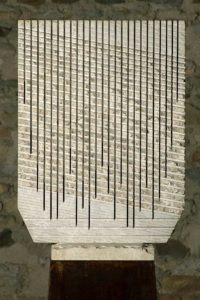Pinuccio Sciola
Biography taken from the website of the Pinuccio Sciola Foundation.
Giuseppe Sciola, known as Pinuccio, was born in San Sperate (SU), Sardinia, in 1942 into a family of farmers. He proudly declared that he attended the “University of Nature”.
He began sculpting at a very young age, and in 1959, as a self-taught artist, he participated in the first Figurative Arts Exhibition for students of all levels, organized by “La Rinascente” in Cagliari. There, he won a scholarship that allowed him to attend the Artistic High School of Cagliari.
After earning his artistic diploma, his relentless curiosity and desire to learn and engage with an international context led him to travel the world, where he met artists such as Giacomo Manzù, Fritz Wotruba, Aligi Sassu, and Henry Moore.
After his experience in Spain, at the University of Moncloa in Madrid, and during the French May student revolt, he returned to his hometown, eager to share with his fellow citizens what he had learned, starting the “white walls” revolution.
In 1973, thanks to a recognition from UNESCO, he worked with the master David Alfaro Siqueiros in Mexico City. Enriched by his artistic and social experience in muralism, he transformed his hometown into what is now known worldwide as the “Museum Village,” where hundreds of open-air artworks can be found, and many artists come to work in the spirit of recovering, preserving and promoting rural and folk traditions.
He received recognition as a sculptor and promoter of culture, art, and social relations in his land, participating in the Italian section of the1976 Venice Biennale, on the theme “The Environment as Social.”
The 1980s and ‘90s were filled with travelling exhibitions, both in Italy and abroad (including the Federal Republic of Germany, Belgium, Luxembourg), in the name of cultural exchange between Sardinia and the rest of the world. His works also began to be exhibited in open spaces.
In 1984, he established an International Stone Carving Centre in San Sperate, eager to teach young people the artisan craft and the art of sculpture. In the “Stones and Cities” exhibition in Milan, the artist showcased both his works and those of his students.
His artistic research reached its peak when, in the early 1990s, he revealed to the world the magic of the sound of stone, perceived not only through sight and touch but also through a third sense: hearing. The “Sonorous Stones” were born and were played for the first time in 1996 by percussionist Pierre Favre at the Time in Jazz Festival in Berchidda, Sardinia.
The sonorous stones, made only of basalt and later of Orosei limestone, are sculptures that produce sounds when “played” with stone or by hand. They recall the forms of Sardinian megalithism but, when observed up close, speak a modern language through their abstract lines and geometric shapes, playing with the relationship between idea and matter.
In 2002, the architect Renzo Piano had a large sonorous basalt work, symbolizing eternal music, installed in the garden of the newly inaugurated Auditorium of Music in Rome on April 21.
In 2003, Sciola returned to the 50th edition of the Venice Biennale with an exhibition in the “Italian Factory” section, entitled Only Stones. A few months later, he exhibited a new series of monumental sculptures, The Canticle of Stones, inspired by Saint Francis’s Canticle of the Creatures, in the square of the Lower Basilica of Assisi.
In the following years, his sonorous stones continued to be featured, along with other works, in exhibitions and interactive installations (e.g., Sculpted Sonorous Installation at the Villa delle Rose in Bologna, 2006).
In 2010, he was appointed President of the Regional Commission for Landscape and Architectural Quality, and on June 12 2012, Pinuccio Sciola was named “Commander of the Order of Merit of the Italian Republic” in honour of his artistic achievements.
He took on the role of set designer for Giacomo Puccini’s Turandot, in the new opera season of the Teatro Lirico in Cagliari, creating a futuristic, almost surreal stone Beijing.
On April 27, 2016, two weeks before his untimely passing, he held his final public event, one of the most significant, as part of the Stone Tales exhibition in the Basilica of San Pietro in Vincoli in Rome, entitled The Voice of Stone – Michelangelo’s Moses and Sciola’s Sonorous Stones.
Pinuccio Sciola passed away on May 13. His beloved village, San Sperate, was shrouded in white, with sheets and drapes hanging from windows and balconies.
Today, Pinuccio Sciola is present in numerous public and private collections in Italy and abroad.
His work continues thanks to the commitment of his three children, who, through the Pinuccio Sciola Foundation, are dedicated to carrying forward his philosophy of art and life. The Foundation and the Sonorous Garden, the artist’s open-air museum, are located at his home-studio.

